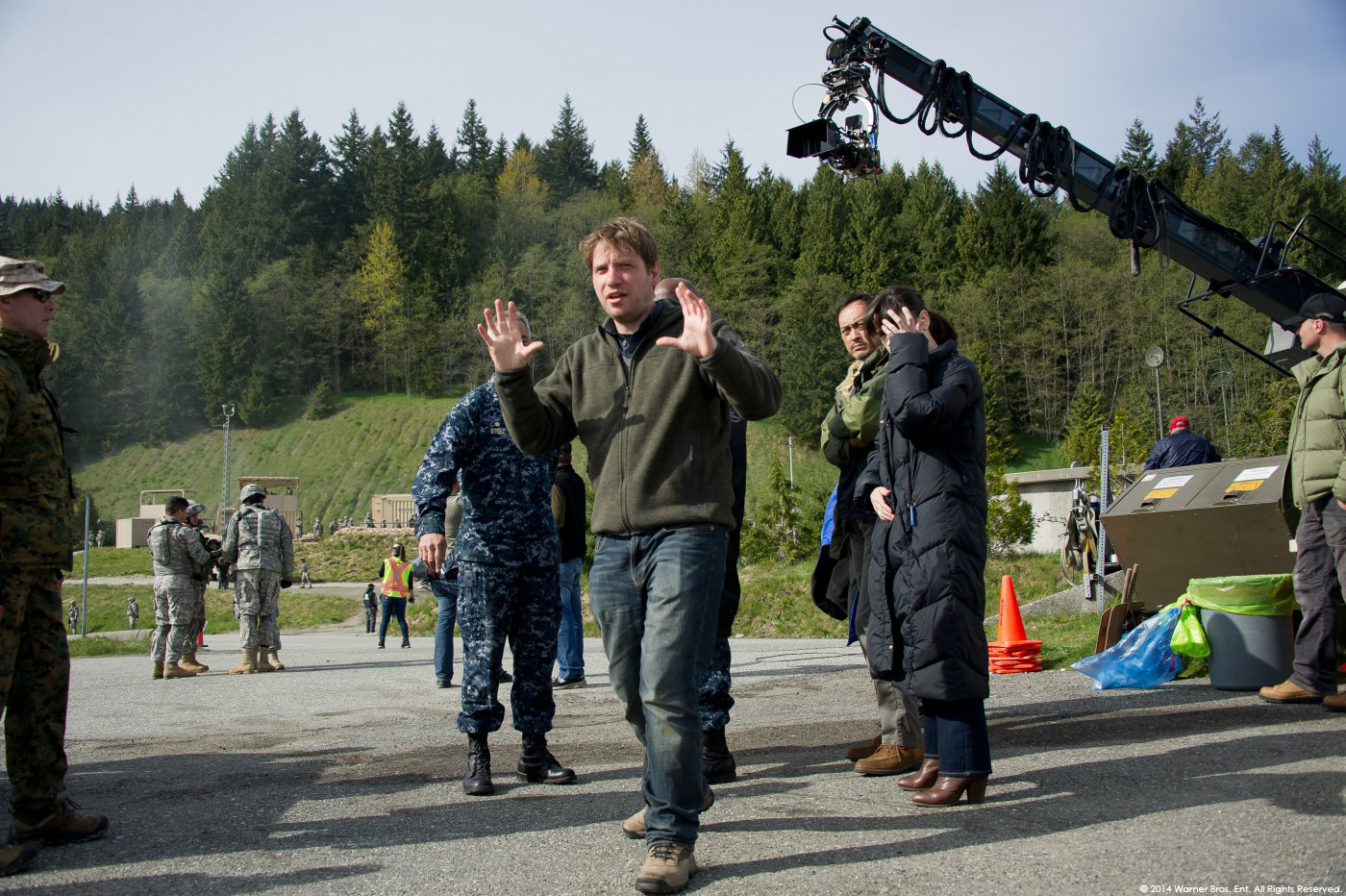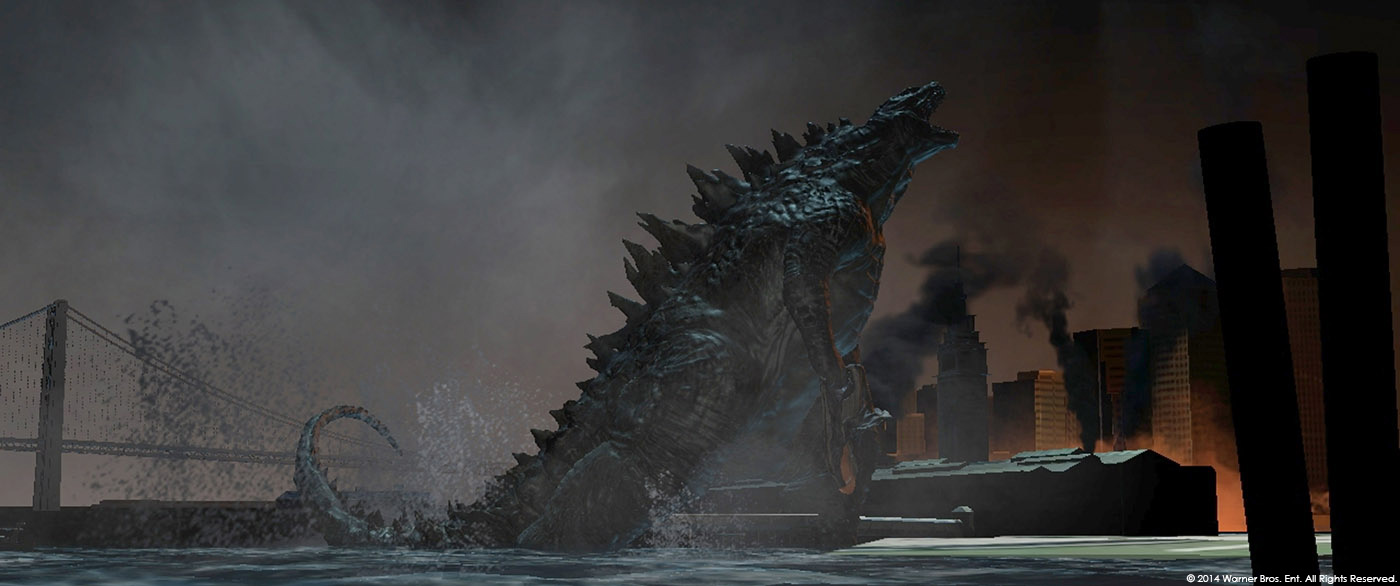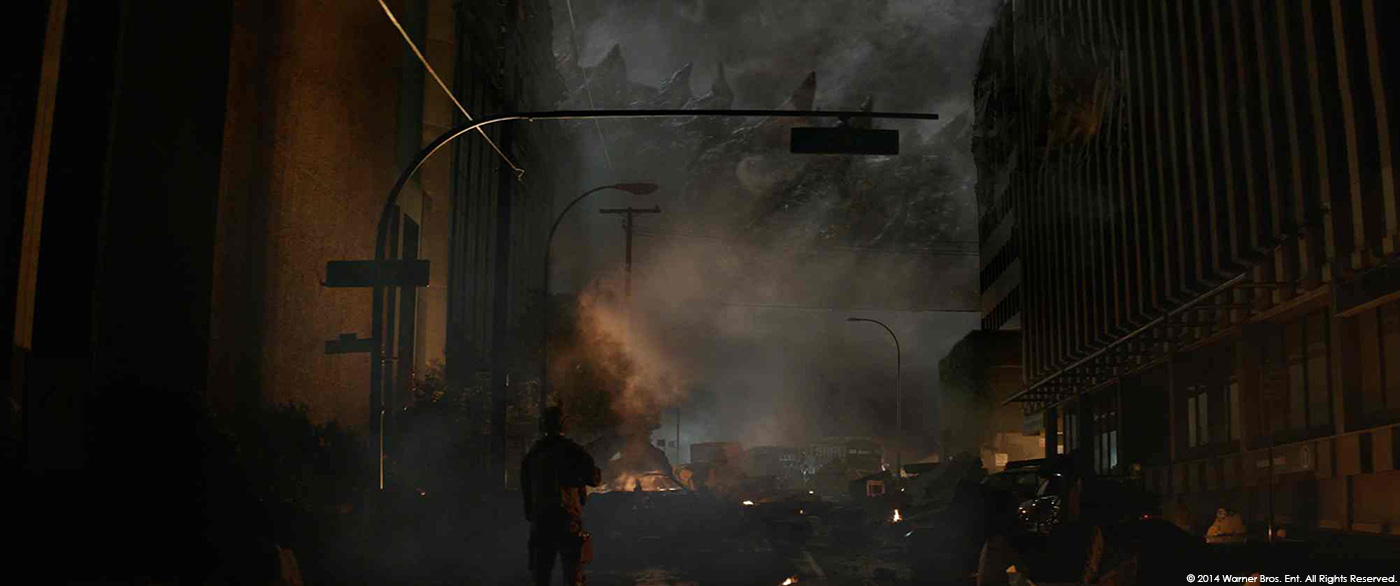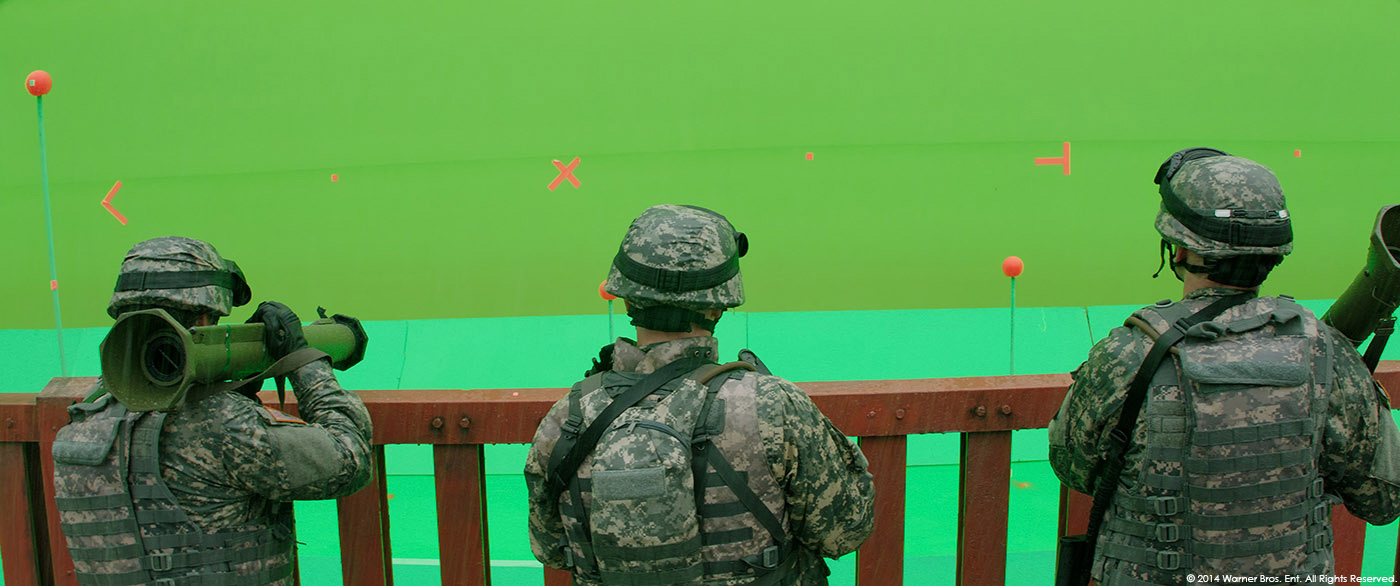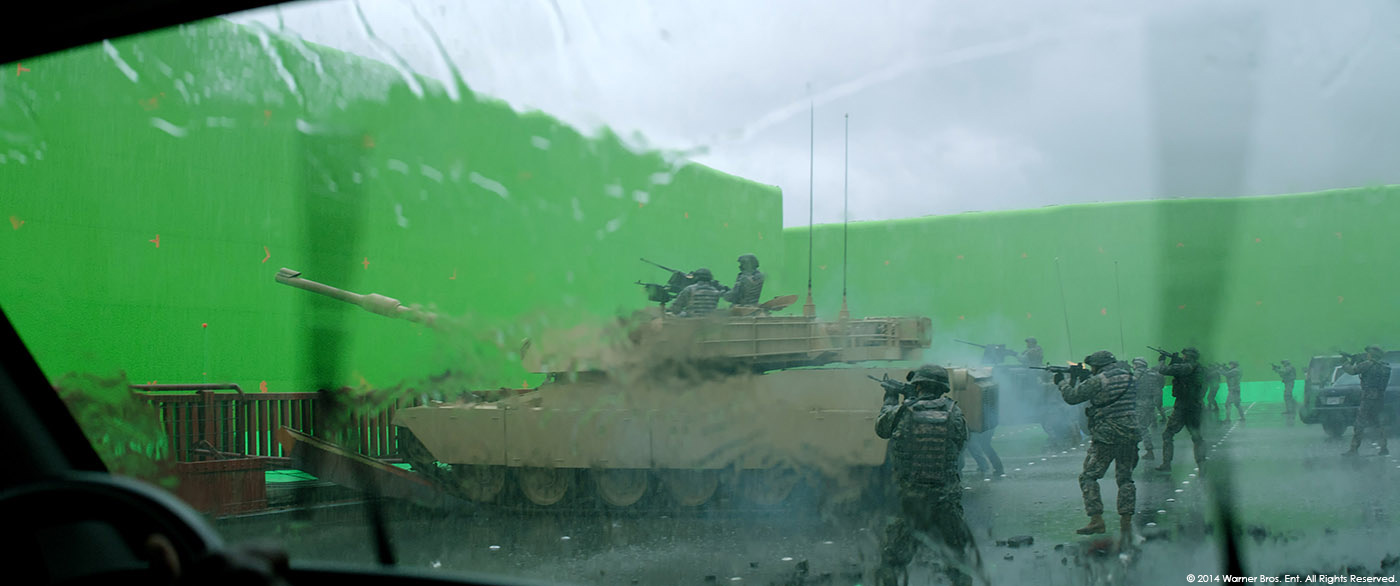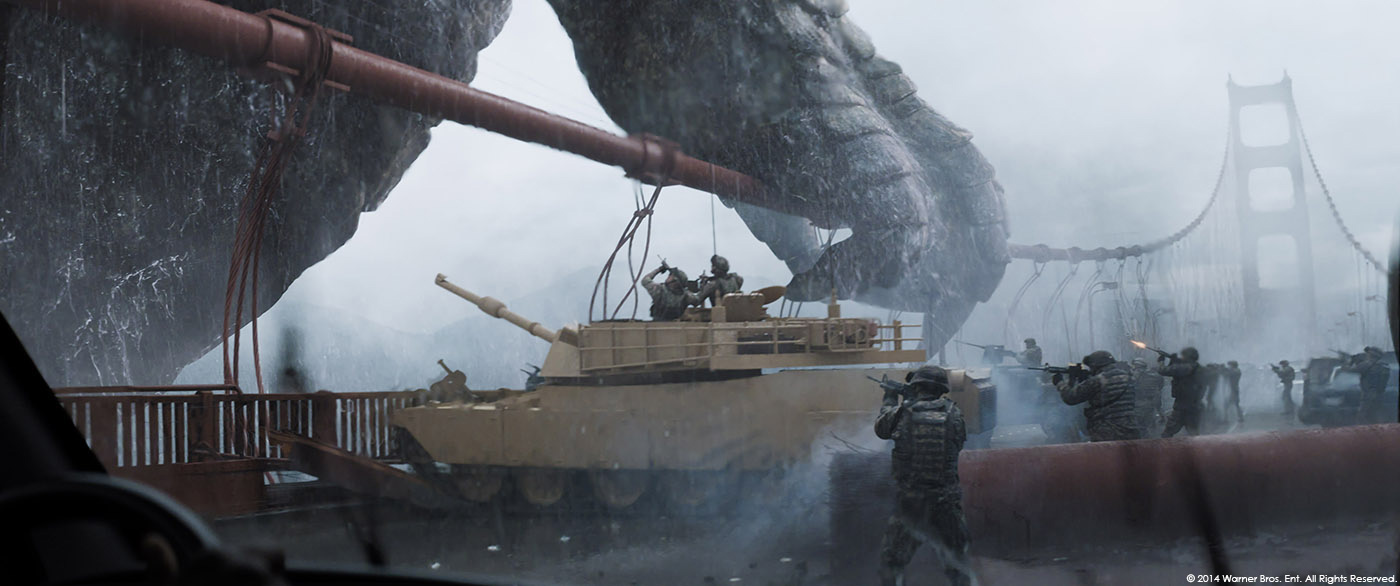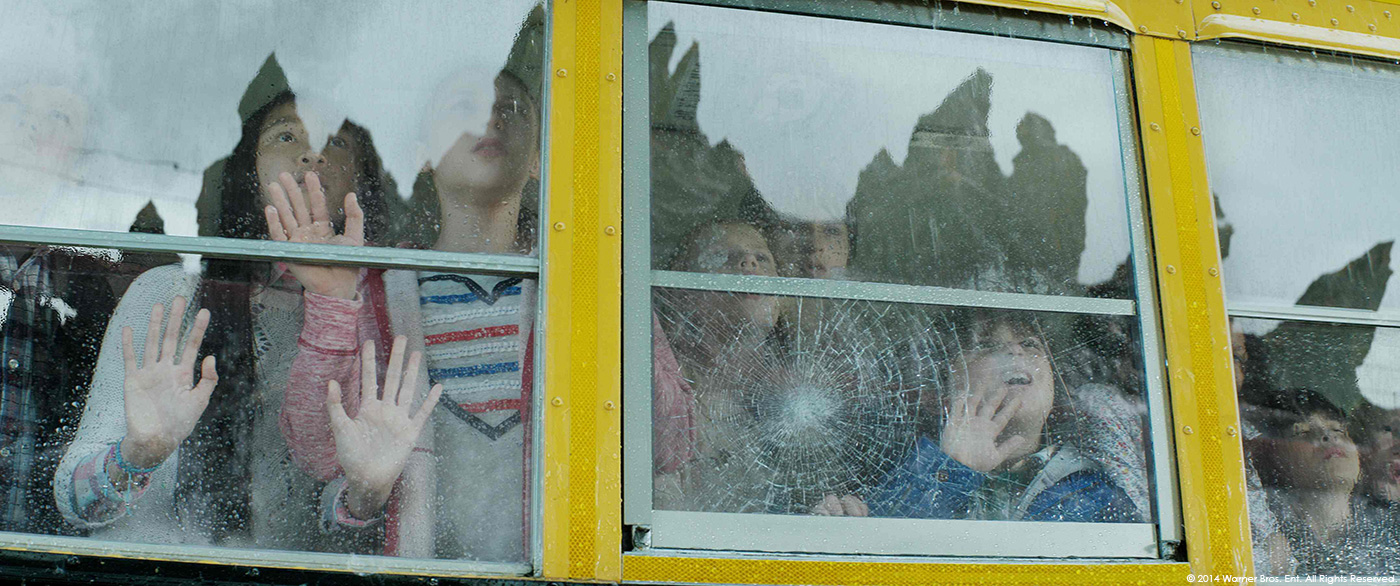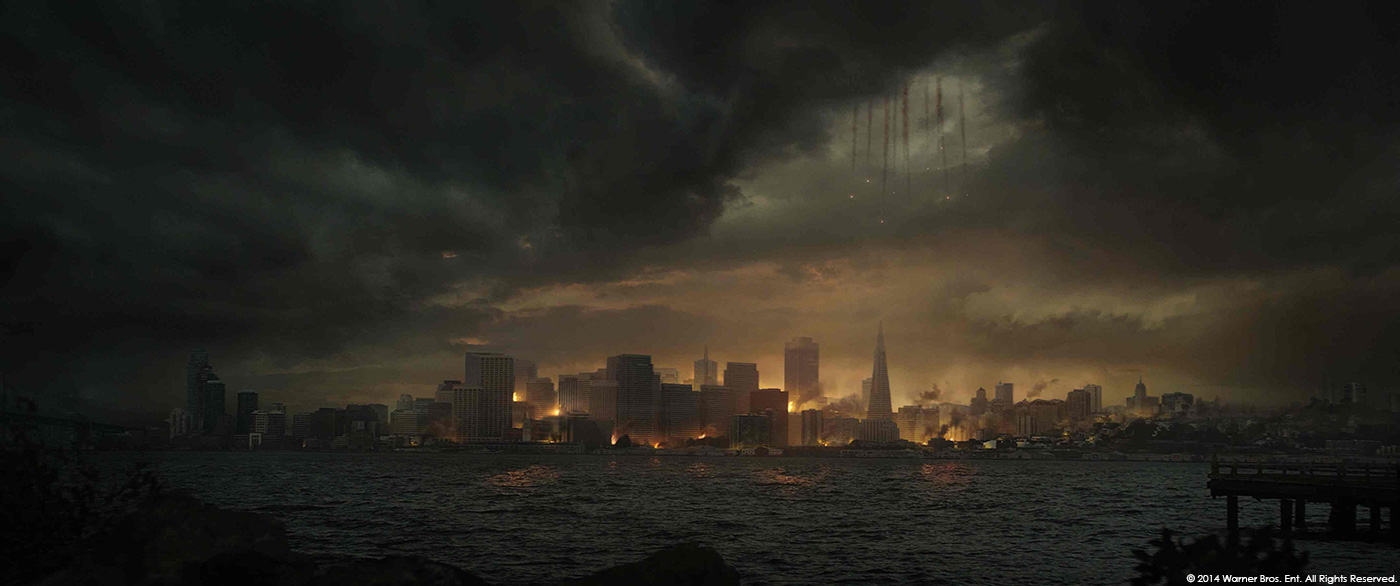Last year, Guillaume Rocheron had explained in details to us the work of MPC on MAN OF STEEL. He then took care of the effects on THE SECRET LIFE OF WALTER MITTY. Today, he talks about his work for the King of the Monsters, GODZILLA.
How did you get involved on this show?
MPC got involved on the show very early on to help Gareth put together a one minute teaser showing his vision and style for the movie. The piece contributed to getting the movie greenlit and was then introduced to the audience at Comicon in 2012. The design of the creatures was still in progress but the piece offered a great snippet of what was to come. It was just over a year later that principal photography started.
How was the collaboration with director Gareth Edwards?
It was terrific to have the chance to work with such a great visual director. Gareth has an inspiring passion for the thriller and monster movie genres and his unique visual flair gave us a fantastic opportunity to help him create an original cinematic experience. As visual effects artists, it was a dream project to bring to life the title character of a movie as iconic as GODZILLA. Regardless of the tremendous technical complexity of some sequences, our ultimate goal was always to drive technology to realize Gareth’s artistic vision.
What was his approach about the visual effects?
Gareth’s background in visual effects served him greatly to actually detach himself from the medium and use them as one of his storytelling tool. His focus was to bring personality to the creatures and to design the CG shots in a realistic way with an emphasis on bringing a graphic and artistic touch to each frame. There are, in theory, no limits to what you can put on screen nowadays with visual effects. It was both stimulating and rewarding to work with a director who uses them to best serve the audience experience, and not just as a technical prowess.
Making GODZILLA was a great collaborative process because we had make sure he didn’t feel like a fantasy creature but still give him personality. It was important for Gareth that we constructed visual effects shots in a plausible way, as if he could have shot them for real. The goal was to make the viewer believe in what’s happening on screen and make it feel as realistic as possible.
How did you collaborate with Production VFX Supervisors Jim Rygiel and John Dykstra?
Jim and John were great at communicating the way Gareth wanted the shots to move forward and working out creative solutions to best realize his vision. We reviewed the various stages of our work via cineSync on a daily basis to collaborate closely on getting the most of each shot.
What have you done on this show?
MPC was responsible for creating Godzilla and the two Mutos during pre-production. We then created all the shots featuring Godzilla starting in the Hawaii airport, as well as the 3rd act of the film comprising of Godzilla and the Mutos arriving in the San Francisco Bay, the Halo Jump and the final showdown in San Francisco.
How was one of your typical days on-set with your team?
The on-set work was divided between myself, Matt Middleton and Axel Bonami, my DFX and Compositing Supervisors. Gareth went through the previs process very thoroughly for the key sequences. The idea was to follow it as closely as possible on set to ensure we could fit the creatures’ actions properly into the shots.
We also did an extensive shoot in San Francisco to capture plates and Envirocams, so Sepp Sonntag my Environment Supervisor, and his team could recreate the city digitally for the 3rd act.
Can you explain in details about the creation of Godzilla and the Mutos?
Godzilla is amongst the most complex CG creatures we have ever created. His sheer size, coupled with the need for attention to intricate detailing of his scales and skin made for a great technical and artistic challenge.
The character took us roughly 7 months to model and texture alone. We started off with a conceptual 3d sculpt that Gareth worked on with the team at Weta Workshop. It provided us with locked proportions and the main features. Our asset department led by Chris Uyede and Rebecca Melander then got involved to find animal references to materialize Godzilla into a creature nature could have created.
We shot a number references of crocodiles, alligators and lizards and started to construct a giant puzzle to identify which features would be appropriate for Godzilla’s various body parts. The result was a cohesive design that would work from both far away and extreme close up. For example, one of his fingernails was roughly the size of a car so the amount of details required to hold up on screen was just phenomenal. Our team sculpted and extracted hundreds of colour and displacement maps from Zbrush and Mari and applied them in shading using vector-based displacement. The lighting and shading played a major part in translating all of those details convincingly.
Joe Everleigh, my Look Development Lead, did extensive research on how different types of scales
and skin catch and reflect the light. He implemented a library of shaders derived from those photographic examples. We used this library in conjunction with the model and textures features to define areas across the body and face that would receive those different real world properties in order to make Godzilla’s skin absorb and reflect the light in many different ways. This contributed to translating his massive scale while keeping him photorealistic. His eyes received a lot of attention to ensure their depth and movements translated the liveliness of the creature.
Our rigging team, led by Dan Zelcs, undertook the massive task of deforming the hundreds of scales covering Godzilla’s body. Starting off with the underlying muscles, many simulation layers were required to get the overall body mass to show weight and subtlety deform and fold the skin. We had to take into account the many different thicknesses of skin on Godzilla’s body and implement how they would affect each other when he moved. For example, when his arm moved, the big scales would slide against each other while pulling the surrounding thinner skin, which would in turn affect the scales all the way up his arm – much like a chain reaction.
The Mutos were original creatures designed by Gareth and concept artist Matt Allsopp. Unlike Godzilla, their shapes were very simple and sleek and we quickly realized that the way they were perceived would be highly dependent on their environment. So instead of doing the traditional build and look development using animation cycles in a controlled lighting environment, we decided to build the 2 creatures directly in a selection of shots. This was a very unconventional approach for such complex assets because each iteration had to go through our entire creature build pipeline to make it into the shots. Mo Sobby, our CG Supervisor, had to find clever ways to make the process as quick and streamlined as possible as it was really the best way to ensure the adjustments were contributing to the design of the shots in the right way.
As we developed their look, we gradually adjusted their facial and body features by playing with the skin patterns, the thickness of the limbs, and the features of the mouth and eyes. The organic limbs were treated like whale or orca skin and we transitioned the flatter surfaces to resemble a crab shell-like surface. This base gave us a lot of skin texture variations for the close-ups as well as larger scale skin properties variations that helped to feature their scale at any size in frame.
The Muto’s eyes went through a lot of design variations to give them a very graphic, almost robotic nature, but at the same time showing they were living creatures. Based on the concept of bioluminescence, their eyes gave us the ability to convey the creature’s emotions by playing with the brightness and speed of their internal light pulse.
How did you handle the creatures performance and animation?
Gareth wanted to ensure Godzilla was viewed as a creation of nature and not a fantasy creature. But it was also important that the audience was not simply following Godzilla’s hunt like an animal documentary but instead rooting or even fearing for him during his battle with the Mutos. We had to make sure he had a presence on screen, with the ability to display attitude and thoughts. One of the ways we did this was by introducing some subtle human elements to his behaviour, especially through his facial expressions and body language to communicate feelings ranging from fearless determination and surprise, to defeat and exhaustion
Our Animation Supervisor, Ferran Domenech, and his team did a terrific job at translating Godzilla’s attitude and balancing out his performances between pure animalistic characteristics and subtle humanistic additions. We studied extensive footage of bear fights and predator behaviours to better understand how to make Godzilla seem like an animal. That said, because nothing exists in reality to directly copy, every aspect of his movements had to be created from scratch.
The emotions conveyed by Godzilla were emphasized by the rhythm of his breathing, cheek puffs, snarls and brow animation. To maintain his imposing stature and iconic silhouette, our animators always kept Godzilla upright and looked for poses that could reveal the dorsal spines. One of the nicer silhouettes we found was to orient the body and the head in such a way that the spines would form a hint of a Mohawk over his head, adding to his fierce look.
The Mutos were treated quite differently. We based their behaviour on the principle that they were a species simply trying to survive. They acknowledged potential threats and their instinct of survival forced them to confront Godzilla and any humans that got in their way. One of the interesting moments of animation in the final battle was when the Mutos strategized their attack by combining their strengths against him knowing they were no match on their own. The male used his speed and ability to fly to destabilize Godzilla while the female used her sheer power to attempt to take Godzilla down at the appropriate time. Like animals do in nature, the Mutos were driven by their instincts but they had the ability to analyse a situation and come up with solutions.
Generally, we established the rule that the creatures would move slower when seen from the ground, where there was a possible speed comparison to a human, and more quickly when the camera was higher than their height. As much as it was a cheat, it helped us keep things dynamic and flowing smoothly. If you consider that Godzilla is a 350ft monster that had to turn around in a couple of seconds, we had to break the barrier of supersonic speed in some shots. Ultimately, taking that liberty was necessary in order to tell the story. One thing Gareth always insisted on was to make sure we had references like vehicles, buildings or rooftops as a comparison element to clearly show the grand scale of the events.
Everybody has a sense of how fast certain elements should move based purely on gravity. So in conjunction with the creatures’ movements, interactive effects such a dust, debris, and water droplets were key components in communicating the scale as they gave the viewers that relationship to gravity.
Can you tell us more about the performance capture process?
Performance capture wasn’t used in a traditional sense mainly because of the scale and anatomical differences between Godzilla and a human performer. It was a good way for Gareth to quickly experiment with different type of attitudes so he could then choose elements that he wanted to read on Godzilla. Andy Serkis and his team at The Imaginarium provided us with studies of spontaneous actions and behaviours. Our animation team was then able to extract certain snippets and integrate them as part of Godzilla’s more human characteristics. In the end, the creatures were completely animated using keyframe animation, but the exercise was a great ode to the traditional GODZILLA films.
Can you explain how you created the Golden Gate Bridge, its environment and the water interaction with Godzilla?
With principal photography done in Vancouver on greenscreen sets, all the San Francisco elements, including the bridge, the boats and the bay had to be created digitally. We did LIDAR scans and photo references of the set and constructed the bridge using modular sections. The full bridge model and textures were done using photogrammetry, using photos shot from a helicopter, a boat and on the bridge itself. Because of its interactions with Godzilla, the bridge was rigged with dynamic cables and support structures.
Our environment leads, Pier Lefebvre and Daniel Rhein, used tiled photography stitched together to recreate the distant environment surrounding the bridge. Basic geometry was created in order to produce depth information that our compositing team, led by Ryan Clarke, could use to layer fog, clouds and rain to create the overcast look of the sequence. To populate the bay, we built Navy transport vessels, cruisers and destroyers as well as F-35, helicopters, cars, tanks and various military vehicles. The bridge and each boat were then dressed with digital soldiers using our crowd simulation tool, Alice.
Using some similar techniques to those we devised in Flowline for LIFE OF PI, our animators keyframed the main water deformations in order to have composition and artistic control over the water structure around Godzilla. This then drove very large areas of water surface simulations as well as hundreds of millions of particles. Each shot needed rain, spray, fine spray, mist and bubbles, all of which interacted with Godzilla emerging and the ships being tossed over. Our FX team, led by Michele Stocco and Ken Beauchamp, had to build art directable simulations to best work in conjunction with the animation, timing and framing of each shot.
How did you create the digital San Francisco for the 3rd act?
Recreating a digital San Francisco was a major element in order to provide control over the cinematography to the filmmakers, as they did practically, but at the scale of an entire city. Dark creatures over a blacked-out city at night wasn’t an ideal natural backdrop to produce compelling photography. We had to have the ability to move buildings around and set city blocks on fire in order to give the creatures a clear contrast against their background.
To give the sequence a natural filming style, it was crucial that shots could be designed for the giant creatures, instead of retrofitting their actions over empty plates. We wanted to have control over the framing, the lighting and the structure of the environment according to the characters we were ultimately filming. With that in mind, we decided to improve on the Envirocam technique we had previously developed, mapping out the many sections required in order to create the city. Five teams of photographers went around the streets and building rooftops of San Francisco to capture all the required references. We then produced high resolution, 700 mega pixel, spherical panoramas from multiple viewpoints, which would be used to extract the 3D geometry and textures of the city.
Our digital environment team then relit the whole city, added non-interactive destruction elements and fire light sources according to the position of the creatures. Using a full deep compositing workflow, the renders were handed over to the compositing team, led by Sean Konrad, to layer strategically positioned fire and smoke elements, and overall atmospherics to achieve the final composition. Ultimately, the goal was to give Gareth the control he needed to art-direct such large-scale shots.
How did you approach this final fight and its choreography?
Even though the battle had massive scope, we always asked ourselves, how would you photograph this if it really happened, and where would you be able to film it safely? I think that’s where Gareth used CGI smartly, as he embraced that showing impressive and massive events from a human point of view could have more impact than creating impossible shots that would feel artificial. He favoured using long operated shots with pretty steady cameras to let the audience appreciate and dive into the spectacle. This pushed us to make sure that our city and creature renderings could sustain long takes and that the atmospherics and destruction simulations could be detailed enough to convey the massive scale.
We defined a perimeter in San Francisco that we called the arena, which our photographic coverage was based upon. The sequence evolved a lot during the postvis process to find the right pace and to develop the creatures’ personalities. The ability to set cameras pretty much anywhere within the arena offered a lot of flexibility when designing and adjusting shots.
With all the destruction happening in the city, keeping track of continuity was extremely important. The postvis team or our animators would define basic beats that our layout, environment and effects team could break down. They would then identify which buildings were destroyed or crumbled in previous shots, the dynamic elements and how they would overlap between shots. In many instances, we had to move buildings around to achieve better composition or just to fit the giant creatures within the city.
Our FX team simulated the city blocks destruction using Kali for the buildings themselves and Flowline for the huge dust clouds generated by the collapse. Additionally, in every city shot, we simulated many layers of interactive dust for the creatures in order to create further interaction with their environment and give them a scale reference against gravity.
The multitude of elements involved in each shot required extensive render times. In order to minimize this as much as possible, we designed the interactive and city CG elements to give more control in compositing so we could focus on the art direction without going through multiple long cycles of rendering. It gave us a way to efficiently adjust the position of the light masses and the density of the dust to create the strong graphic composition that was so important to Gareth’s visual style.
During the fight lots of destruction happens. Can you explain in details about it and the use of Kali?
Kali is a robust production tool that we have used for many years now. On this project, our main focus was to improve the artist controls in order to precisely choreograph the destruction. Kali allowed us to use a very realistic base thanks to its concept of material properties and the ability to account for all construction layers, including the interior, supporting structures and windows. Our R&D and FX team improved methods for artists to force certain behaviours such as weak areas or explosiveness to work in conjunction with the creatures’ actions.
The other challenge was for it to handle the volume of data required to destroy an entire skyscraper or a complete city block from a simulation and rendering standpoint.
Godzilla is breathing his atomic breath. Can you tell us more about its creation?
Designing the atomic breath was challenging because our goal was to treat everything as realistically as possible and we suddenly had to give Godzilla blue fins and create a massive blue beam coming out of his mouth.
For the beam itself, we used archive footage of tanks firing napalm blasts as reference. This provided us with an organic quality without it looking like a small flamethrower. The beam and impact were created using fluid simulations, emitting a core of fast flowing fuel that would be used as source for the fire elements. We cheated various forces to make the flames travel very fast towards the target point, making the effect extremely dynamic by creating flicker and pulsing.
The blue fins were developed by our lookdev team and were treated as flow of napalm running up the spine that was bleeding through the thinner parts of the fins surface. We emitted white light from the base of each fin and gave the blue tint through the colour bleeding on the thin areas, which was enough to give the classic colour while keeping the effect as photographic as possible.
How did you approach the beautiful HALO jump sequence?
From the start, the HALO jump was definitely a favourite sequence of mine. I just loved how graphic it was and the concept of the calm before the storm, with the soldiers going through those big quiet vistas and slowly entering into an inferno.
The sequence was a mix of all CG shots and practical photography with skydivers equipped with helmet mounted RED cameras. For these shots, we roto-ed out the soldiers, replaced the entire environment and added the red smoke trails.
The cloudscapes were created using multiple layers of clouds to create parallax and give a sense of depth and scale. The wider vistas, painted by our environment team, were made by using multiple photo references manipulated in order to achieve the apocalyptic lighting and compositions. The smoke trails were simulated using fluid simulations forming those straight red lines cutting against the sky, making the graphic signature look of the sequence.
As the jumpers finally approach San Francisco, we used our CG city environment as well as digital soldiers in order to choreograph the shots according to the buildings and the creatures. The creatures were kept very obscure on purpose so we could reveal them through a succession of staccato lightning flashes reinforcing the tension and surprise of the landing into the city.
How did you work with Double Negative teams?
We have worked on multiple shows with them so it was smooth and streamlined. We shared models and textures we had created for the two Mutos and a high resolution of Godzilla’s back and fins for their sequences. To ensure continuity, we made turntables using shared HDRIs so they could replicate our look development. We communicated back and forth about how all the various textures had to be used and how the shaders were designed.
What was your feeling to be in the Godzilla universe?
The passion and excitement from everybody involved in the film to revive GODZILLA through Gareth’s vision.
What did you keep from this experience?
The incredible dedication of the team at MPC. The fact that Gareth treated the movie with an inventive visual language got us all excited to make the creatures come to life and to create the singular type of images that he had envisioned.
How long have you worked on this film?
We started pre-production in February 2013 and completed the shots in early April 2014, so roughly fifteen months of production. Including the 2012 Comicon piece, around two and a half years.
How many shots have you done?
Around 350, most of them being the 40 minutes final act of the film.
What was the size of your team?
Our hub was at MPC Vancouver but our teams in Bangalore and London both got involved on various aspect of the work. In total, I believe around 400 people worked on GODZILLA.
What is your next project?
Let’s just say I’m excited about what’s coming!
A big thanks for your time.
// WANT TO KNOW MORE?
– MPC: Dedicated page about GODZILLA on MPC website.
// MPC GODZILLA VFX BREAKDOWN (SNEAK PEAK)
© Vincent Frei – The Art of VFX – 2014


